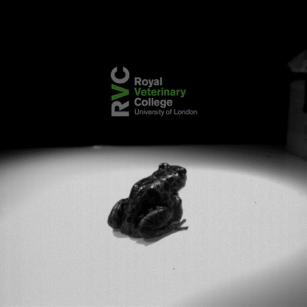Made for the long jump: RVC study reveals how frogs use their unique skeletal anatomy to improve their jumping capabilities

As well as their long legs, a particularly striking feature of a frog's skeletal anatomy is a sharp bend in their lower back. Underlying this bend is the ilio-sacral (IS) joint - a hinge-like pivot which allows the frog to control the angle between its upper and lower body. The IS joint is folded when a frog is sitting at rest to allow the frog to crouch closely to its perch.
During the explosive early moments of a jump, a frog's muscles extend the IS joint to rapidly straighten its back. Until now, biologists believe the IS hinge was an essential part of the anatomy, allowing a force transfer between the upper and lower body of the frog which enabled the jump.
However, a recent study conducted by the Royal Veterinary College (RVC) was able to find that, contrary to prior understanding, this IS extension is not required for jumping but more of an evolutionary innovation for fine-tuning a frog’s jump performance.
The research team, which consisted of Dr Christopher Richards, Dr Amber Collings and Enrico Eberhard, developed a simulation of a frog jumping using 3D computer technology. This simulation model was unique because it allowed the researchers to calculate the frog's push off from the ground, rather than directly measuring it. From further analysis the team were also able to isolate the influence of the IS joint by changing its action, whilst maintaining the consistency of all other body motions.
This research was funded by a European Research Council Starting Grant and will feature in a new paper published this week in the Royal Society journal Biology Letters.
Dr. Christopher Richards, Research Fellow in Paleorobotics at the RVC, said:
"We are particularly excited about this study because we think our methods open new doors for exploring how specific anatomical features affect animal locomotion."
Notes to Editors
For more information please contact: Alex Cassells or Steven Gauge Press Line: 0800 368 9520
About the Royal Veterinary College
- The Royal Veterinary College (RVC) is the UK's largest and longest established independent veterinary school and is a constituent College of the University of London.
- The RVC offers undergraduate, postgraduate and CPD programmes in veterinary medicine, veterinary nursing and biological sciences.
- It is currently the only veterinary school in the world to hold full accreditation from AVMA, EAEVE, RCVS and AVBC.
- In 2017, the RVC received a Gold award from the Teaching Excellence Framework (TEF) – the highest rating a university can receive.
- A research-led institution, in the most recent Research Excellence Framework (REF2014) the RVC maintained its position as the top HEFCE funded veterinary focused research institution.
- The RVC ranked as the top vet school in the Agriculture, Veterinary and Food Science unit of the most recent Research Assessment Exercise, with 55% of academics producing world-class and internationally excellent research.
- The RVC also provides animal owners and the veterinary profession with access to expert veterinary care and advice through its teaching hospitals; the Beaumont Sainsbury Animal Hospital in central London, the Queen Mother Hospital for Animals (Europe's largest small animal referral centre), the Equine Referral Hospital, and the Farm Animal Clinical Centre located at the Hertfordshire campus.
